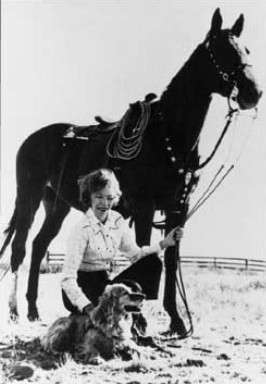Velma Bronn Johnston
Velma Bronn Johnston (March 5, 1912 — June 27, 1977), also known as Wild Horse Annie, was an animal welfare activist. She led a campaign to stop the eradication of mustangs and free-roaming burros from public lands. She was instrumental in passing legislation to stop using aircraft and land vehicles from inhumanely capturing wild horses and burros.

Personal life
Velma Bronn was born in Reno, Nevada to Joseph Bronn and his wife Gertrude Clay,[1] and grew up on the family’s "Lazy Heart Ranch". In 1923 she contracted polio and was confined to a cast for six months.[2]
She married Charles Johnston and they took over operation of the ranch, later turning it into the "Double Lazy Heart Ranch", a dude ranch for children. The name of the ranch was changed so as to include Charles in the family business.
Johnston also worked as a secretary for an insurance company.
Fight for humane treatment of free-roaming horses
Driving to work one day in 1950, Johnston was following a truck overcrowded with horses and saw blood dripping from the back. She followed it to a slaughterhouse,[3] and upon learning they were free-roaming horses gathered from private and state lands in Nevada's Virginia Range, she took action to ensure more humane treatment of free-roaming horses when captured and transported.
On her initiative and Nevada State Senator Walter Baring's actions, Nevada passed a bill that made free-roaming roundups by planes and cars illegal on state and private lands.[4] Although the free-roaming horses on all lands in the state were under the jurisdiction of the state estray laws, federal lands, administered chiefly by the Bureau of Land Management and the Forest Service, which comprise almost 85% of the lands in Nevada,[5] were exempt from the law due to objections from the agencies that the law would hamper attempts to remove the horses from the federal lands. As large parts of Nevada were thereby excluded from the bill, Johnston continued to fight for protection of the free-roaming horses throughout the state and across all the federal lands in the west. She initiated a massive letter-writing campaign by students to Senators and Congressmen. On September 8, 1959, the campaign resulted in the federal legislature passing Public Law 86-234, which banned the poisoning of watering holes frequented by wild equids and the use air and land vehicles in hunting and capturing free-roaming horses for sale and slaughter. This became known as the Wild Horse Annie Act.[6]
Passage of the Wild Horse Annie Act did not alleviate the concerns of free-roaming horse advocates, who continued to lobby for federal rather than state control over the disposition of free-roaming horses. Since most horses in the desert regions were recently descended from ranchers' horses, ownership of the free-roaming herds was contentious, and ranchers continued to use airplanes to gather them. Johnston continued her campaign, and in 1971, the 92nd United States Congress unanimously passed the Wild and Free-Roaming Horses and Burros Act of 1971.[7] It was signed into law by then-President Richard Nixon on December 15, 1971. The act prohibited capture, injury, or disturbance of free-roaming horses and burros.
Legacy
In 1959, Johnston was featured in Time magazine.[8] The 1961 western The Misfits, based on a script by Arthur Miller, the last film of Clark Gable and Marilyn Monroe and also starring Montgomery Clift, portrayed a horse roundup of the sort Johnston had protested; in the film, Monroe's character becomes disgusted with the method, which leads to a climactic clash between the characters.
Johnston herself appeared in the Robert McCahon 1973 western Running Wild as herself, starring alongside Lloyd Bridges and Dina Merrill.
Johnston died at age 65 of lung cancer in Reno, Nevada on June 27, 1977. She is buried alongside her parents, husband and brother in the Mountain View Cemetery in Reno.
References
- Cruise, David; Griffiths, Alison (2010). Wild Horse Annie and the Last of the Mustangs: The Life of Annie Johnston. Simon & Schuster. p. 5. ISBN 978-1-4165-5335-9.
- "More About Wild Horse Annie". Archived from the original on 5 December 2011. Retrieved 19 November 2011.
- "History and Facts". Bureau of Land Management. Archived from the original on December 28, 2015. Retrieved January 18, 2016.
- https://americanwildhorsecampaign.org/wild-horse-annie-act
- https://www.fas.org/sgp/crs/misc/R42346.pdf
- "History of the Program: The Wild Horse Annie Act". Bureau of Land Management. Retrieved 19 November 2011.
- "The Wild Free-Roaming Horses and Burros Act of 1971 (Public Law 92-195)". Bureau of Land Management. Retrieved 19 November 2011.
- "ANIMALS: Wild Horse Annie", Time Magazine, 27 July 1959, retrieved 30 December 2009
Further reading
- Marguerite Henry (1966). Mustang. Wild Spirit of the West. Chicago: Rand McNally & Company. (children's lit)
- David Phillips (2017). “Wild Horse Country: The History, Myth, and Future of the Mustang.” W. W. Norton & Co.
- Alan J. Kania (2012). "Wild Horse Annie: Velma Johnston and her Fight to Save the Mustang." University of Nevada Press.
- Deanne Stillman (2008). "Mustang: The Saga of the Wild Horse in the American West." Houghton Mifflin.
- Mitchell Bornstein (2015) "Last Chance Mustang". New York: St. Martin's Press.
External links
- Velma Bronn Johnston on IMDb
- "History of the Wild Horse Annie Act". Bureau of Land Management. Archived from the original on 21 February 2008.
- "Denver Collected papers of Velma Johnston at Denver library". Denver Public Library. Retrieved 30 December 2009.
- "Wild Horse Annie, International Society for the protection of Mustangs and Burro's first president". International Society for the protection of mustangs and burros. Retrieved 30 December 2009.
- "American wild horse sanctuary". Return To Freedom. Archived from the original on 10 March 2009. Retrieved 30 December 2009.
- article from 2005 about recent challenges to the legislation that "Wild Horse Annie" fought for (The Christian Science Monitor)